The acidic protein rich in leucines Anp32b is an immunomodulator of inflammation in mice
- PMID: 30890743
- PMCID: PMC6424966
- DOI: 10.1038/s41598-019-41269-z
The acidic protein rich in leucines Anp32b is an immunomodulator of inflammation in mice
Abstract
ANP32B belongs to a family of evolutionary conserved acidic nuclear phosphoproteins (ANP32A-H). Family members have been described as multifunctional regulatory proteins and proto-oncogenic factors affecting embryonic development, cell proliferation, apoptosis, and gene expression at various levels. Involvement of ANP32B in multiple processes of cellular life is reflected by the previous finding that systemic gene knockout (KO) of Anp32b leads to embryonic lethality in mice. Here, we demonstrate that a conditional KO of Anp32b is well tolerated in adult animals. However, after immune activation splenocytes isolated from Anp32b KO mice showed a strong commitment towards Th17 immune responses. Therefore, we further analyzed the respective animals in vivo using an experimental autoimmune encephalomyelitis (EAE) model. Interestingly, an exacerbated clinical score was observed in the Anp32b KO mice. This was accompanied by the finding that animal-derived T lymphocytes were in a more activated state, and RNA sequencing analyses revealed hyperactivation of several T lymphocyte-associated immune modulatory pathways, attended by significant upregulation of Tfh cell numbers that altogether might explain the observed strong autoreactive processes. Therefore, Anp32b appears to fulfill a role in regulating adequate adaptive immune responses and, hence, may be involved in dysregulation of pathways leading to autoimmune disorders and/or immune deficiencies.
Conflict of interest statement
The authors declare no competing interests.
Figures
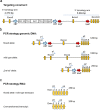



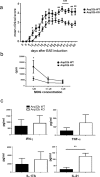
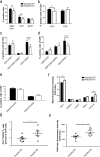
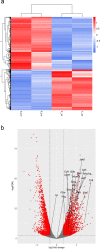
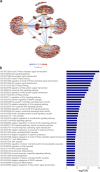
Similar articles
-
ANP32B Deficiency Protects Mice From Lethal Influenza A Virus Challenge by Dampening the Host Immune Response.Front Immunol. 2020 Mar 13;11:450. doi: 10.3389/fimmu.2020.00450. eCollection 2020. Front Immunol. 2020. PMID: 32231671 Free PMC article.
-
Acidic nuclear phosphoprotein 32kDa (ANP32)B-deficient mouse reveals a hierarchy of ANP32 importance in mammalian development.Proc Natl Acad Sci U S A. 2011 Jun 21;108(25):10243-8. doi: 10.1073/pnas.1106211108. Epub 2011 Jun 2. Proc Natl Acad Sci U S A. 2011. PMID: 21636789 Free PMC article.
-
ANP32B deficiency impairs proliferation and suppresses tumor progression by regulating AKT phosphorylation.Cell Death Dis. 2016 Feb 4;7(2):e2082. doi: 10.1038/cddis.2016.8. Cell Death Dis. 2016. PMID: 26844697 Free PMC article.
-
B7-H3 Promotes Pathogenesis of Autoimmune Disease and Inflammation by Regulating the Activity of Different T Cell Subsets.PLoS One. 2015 Jun 11;10(6):e0130126. doi: 10.1371/journal.pone.0130126. eCollection 2015. PLoS One. 2015. PMID: 26065426 Free PMC article.
-
TRAIL-Mediated Suppression of T Cell Receptor Signaling Inhibits T Cell Activation and Inflammation in Experimental Autoimmune Encephalomyelitis.Front Immunol. 2018 Jan 22;9:15. doi: 10.3389/fimmu.2018.00015. eCollection 2018. Front Immunol. 2018. PMID: 29403497 Free PMC article.
Cited by
-
The Interplay between Retinal Pathways of Cholesterol Output and Its Effects on Mouse Retina.Biomolecules. 2019 Dec 12;9(12):867. doi: 10.3390/biom9120867. Biomolecules. 2019. PMID: 31842366 Free PMC article.
-
Polypyrimidine tract binding proteins PTBP1 and PTBP2 associate with distinct proteins and have distinct post-translational modifications in neuronal nuclear extract.PLoS One. 2025 Jun 4;20(6):e0325143. doi: 10.1371/journal.pone.0325143. eCollection 2025. PLoS One. 2025. PMID: 40465779 Free PMC article.
-
The CD83 Molecule - An Important Immune Checkpoint.Front Immunol. 2020 Apr 17;11:721. doi: 10.3389/fimmu.2020.00721. eCollection 2020. Front Immunol. 2020. PMID: 32362900 Free PMC article. Review.
-
Revealing disease subtypes and heterogeneity in common variable immunodeficiency through transcriptomic analysis.Sci Rep. 2024 Oct 12;14(1):23899. doi: 10.1038/s41598-024-74728-3. Sci Rep. 2024. PMID: 39396099 Free PMC article.
-
ANP32B Deficiency Protects Mice From Lethal Influenza A Virus Challenge by Dampening the Host Immune Response.Front Immunol. 2020 Mar 13;11:450. doi: 10.3389/fimmu.2020.00450. eCollection 2020. Front Immunol. 2020. PMID: 32231671 Free PMC article.
References
Publication types
MeSH terms
Substances
LinkOut - more resources
Full Text Sources
Molecular Biology Databases
Research Materials
Miscellaneous

